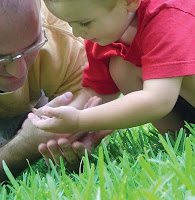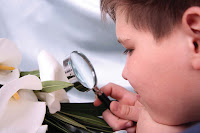Children are natural observers. They are fascinated by the phenomenon found in the natural world. I remember taking my son to the zoo when he was a toddler, thinking he’d be fascinated by the large, exotic animals. I was surprised when what captured his imagination most were the tiny trails of black ants he found around the all along the ground. “Look, Mommie! More ants!” he’d cry to the delight of those around him. My mother relayed a similar incident with my 18-month old niece. On a recent trip to the San Diego zoo, she spent close to an hour watching and imitating the flamingos. She was perfectly content to give her entire focus and attention to learning about these fascinating birds without any adult intervention. Enjoy this in depth look as we explain Montessori Science curriculum materials, activities, and philosophy.
Montessori Curriculum Explained: Sciences Materials, Activities and Philosophy
Montessori Science: Ages 0-6 Science is all around us. Young children interact with the natural world everywhere they go. Investigating what flowers smell like, how a leaf feels, or what happens when you pull the cat’s tail is how they learn how things work and how they are to interact with it. Maria Montessori recognized the young child’s need to observe and absorb information about the world around them. She believed that experience with real objects should always proceed before learning the names or looking at pictures of things.
Science is all around us. Young children interact with the natural world everywhere they go. Investigating what flowers smell like, how a leaf feels, or what happens when you pull the cat’s tail is how they learn how things work and how they are to interact with it. Maria Montessori recognized the young child’s need to observe and absorb information about the world around them. She believed that experience with real objects should always proceed before learning the names or looking at pictures of things.Encountering something new in natures sparks the child’s curiosity and leads to a spontaneous lesson as the child asks “What is this? What is it called? How does it feel/smell/taste/sound?” These sensorially-based questions are concrete evidence of the child’s stage of development. In this sensitive period, children should be encouraged to explore their environment with their senses. Once their senses have been awakened, they can be shown more abstract concepts such as how to care for plants, how to feed and water the class pet, the different shapes found in leaves, the parts of a turtle or butterfly. Montessori realized that young children in the period of the absorbent mind have a real need to learn the proper names for things. She created the Montessori nomenclature materials (3-part cards, charts, and booklets along with their controls of error) to help children develop their vocabulary and increase their understanding of the world around them.
Philosophy is written in that great book which ever lies before our gaze -- I mean the universe -- but we cannot understand if we do not first learn the language and grasp the symbols in which it is written. The book is written in the mathematical language, and the symbols are triangles, circles, and other geometrical figures, without the help of which it is impossible to conceive a single word of it, and without which one wanders in vain through a dark labyrinth. ~Galileo Galilei
Montessori Science: Lower Elementary
The lower elementary aged child enters what Montessori called the age of the “reasoning mind”. They now ask questions which begin with “How” and “What if…?” They move beyond themselves and the need to learn names and parts and are able to think more abstractly and see what may be. It is now, where Montessori’s idea of Cosmic Education is presented through the telling of The Five Great Lessons. These imaginative stories provide the framework whereupon the secrets of the universe are presented in the Montessori classroom. Exploration of these concepts is then reinforced by the use of experiments and Montessori impressionistic charts. This is the beginning of the development of scientific thought. Montessori students’ questions become their hypothesis and through the power of observation, they come to their own conclusions about the laws of the universe.
Children in the lower elementary Montessori classroom are introduced to a wide array of scientific principles:
Classification of living and non-living things, including Linnaean classification of plants and animals.
Zoology
- The difference between plants and animals.
- Identifying and classifying animals
- Identifying parts of insects, arachnids, crustaceans, mollusks, fish, amphibians, reptiles, birds, and mammals
- Basic needs of animals
- Animal homes
- Reproduction
- Lifecycles
- Food chains
- Adaptation
- Animal defense mechanisms
- Investigating how humans use animals
- Caring for captive animals
- Human organ systems
- Basic needs of plants
- Parts of herbaceous plants
- Parts of trees & shrubs
- Identification of roots, stems, leaves, seeds, fruit
- Transpiration
- Growing and caring for indoor and outdoor plants
- Investigating how people use plants
- Self-esteem
- Systems of the human body
- Nutrition
- Physical education
Matter
- Atoms & molecules
- The periodic table of elements
- States of matter
- Elements, compounds, and mixtures
Still directly tied to the Five Great Lessons, the Montessori upper elementary science curriculum is about further development of the scientific method. Children now have the ability to focus on in-depth research. They are able to actively engage with what interests them by conducting experiments based on scientifically formulated hypotheses, collecting and interpreting data, and presenting their results. This is a time when Montessori classroom or school science fairs can be used to encourage scientific exploration, research, and promote the sharing of ideas with others.
Scientific inquiry in the Montessori upper elementary classroom encompasses:
Botany
- Root systems & functions
- Photosynthesis and transpiration
- Plant vascular system and function
- Pollination
- Identifying common flowers, trees, shrubs
- Using a field guide
- Plant adaptations
- Advanced classification
- Types of roots, fruits, and seeds
- Dissection seeds and flowers
- Germination and propagation
- Cell structure of plant and animal cells
- Food spoilage and preservation
- Systems of the human body
- Microorganisms and hand washing
- Safe food handling
- Nutrition
- Personal hygiene
- Internet safety
- Human life cycle
- Atomic structure
- Advanced study of states of matter
- Acids & bases
- Water density
- Chemical formulas
- Using a microscope
- Gathering data
- Using the scientific method for experiments
- Using a triple-beam scale
- Roman arches
- Simple machines
- Animal routines
- Animal sounds
- Advanced classification
- Basic needs of animals
- Organ systems
- Reproduction
- Adaptations
- Rehabilitation
See other related NAMC blogs:
- Montessori Curriculum Overview: Geography
- Montessori Curriculum Overview: Language Arts
- Montessori Curriculum Overview: Math
As much as possible, NAMC’s web blog reflects the Montessori curriculum as provided in its teacher training programs. We realize and respect that Montessori schools are unique and may vary their schedules and offerings in accordance with the needs of their individual communities. We hope that our readers will find our articles useful and inspiring as a contribution to the global Montessori community.
© North American Montessori Center - originally posted in its entirety at Montessori Teacher Training on Friday, July 16, 2010.
© North American Montessori Center - originally posted in its entirety at Montessori Teacher Training on Friday, July 16, 2010.


Michelle:
ReplyDeleteCongratulations on writing an excellent series on Montessori curriculum. Very informative; although I don't teach in a Montessori system, after reading your blogs on curriculum, I would really like the Montessori approach.
Hi Tim,
ReplyDeleteThank you for your kind comments. Montessori is more than just a system of education, it is an educational philosophy that can be applied in even the most traditional of settings. May I kindly suggest the following blog which outlines further reading on the Montessori philosophy of education? http://montessoritraining.blogspot.com/2010/04/creating-montessori-parent-and-faculty.html
Michelle:
ReplyDeleteThanks for the suggestion-it is a great help to me.
This is in my opinion one of the best list of science activity ideas of things to do with childrens .I have kept a duplicate of this list for my home futur classroom . Thank you so much :)
ReplyDeleteI'm interested in learning more about Montessori Science pedagogy and how to apply it to a k-5 teaching curriculum. This is a great first step, but could you also point me towards further resources?
ReplyDelete